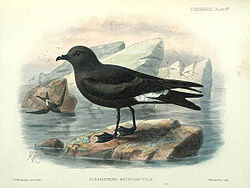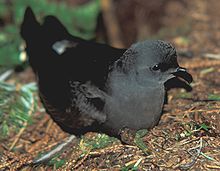- Guadalupe Storm Petrel
-
Guadalupe Storm Petrel 
Illustration from 1907 Conservation status Scientific classification Kingdom: Animalia Phylum: Chordata Class: Aves Order: Procellariiformes Family: Hydrobatidae Subfamily: Hydrobatinae Genus: Oceanodroma Species: O. macrodactyla Binomial name Oceanodroma macrodactyla
W.E. Bryant, 1887Synonyms Oceanodroma leucorhoa macrodactyla W.E. Bryant, 1887
The Guadalupe Storm Petrel (Oceanodroma macrodactyla) is a small seabird of the storm petrel family Hydrobatidae. It is apparently extinct.
Contents
Description and ecology
 Sitting on its nest, the Guadalupe Storm Petrel would have looked exactly the same as the Leach's Storm Petrel in this photo
Sitting on its nest, the Guadalupe Storm Petrel would have looked exactly the same as the Leach's Storm Petrel in this photo
This species was almost indistinguishable from its relative, Leach's Storm Petrel. In the field, they could not be told apart except by their circannual rhythm. In the hand, the Guadalupe Storm Petrel could be distinguished by slightly larger size and the paler underwing coverts.[1]
It bred only on Guadalupe Island off Baja California (Mexico), and presumably ranged throughout the region. The breeding season was set between that of the local subspecies of Leach's Storm Petrel, the winter-breeding Oceanodroma leucorhoa cheimomnestes and the summer-breeding O. l. socorroensis, in accordance with Gause's Law.[2]
The single egg, white with a faint ring of reddish-brown and lavender speckles around the blunt end, was laid in burrows maybe 15 inches (35–40 cm) long, below the Guadalupe Pine (Pinus radiata var. binata)-Island Oak (Quercus tomentella)[3] cloud forest on top of Mount Augusta. By mid-June, almost all young had already left the burrows. Though there is little data on Oceanodroma breeding, incubation was presumably 42 days or so in this species, just as in similar-sized relatives. Time to fledging must have taken between 60 and 75(-85?) days, most likely around 65 days. This would mean that egg-laying took place from early February to March, and that in April–May, unfledged young were present in most active burrows. just as in their relatives, the egg was incubated a few days by either parent, after which the other took over, the relieved bird taking to the sea to satiate themselves for the next incubation stint. The young were fed only at night, also like in other storm-petrels.[4]
Three species of lice were found to parasitize the Guadalupe Storm Petrel: the menoponids Longimenopon dominicanum and Austromenopon oceanodromae, and the ischnoceran Halipeurus raphanus. The second also occurs on some other storm petrels, and the third was also found on the Ashy Storm Petrel. L. dominicanum on the other hand has to date not been found on other birds and seems to be a case of coextinction.[5]
Disappearance
The introduction of cats to the island decimated the population during the late 19th century. By the end of the 1906 breeding season, it was still considered "abundant"[6] though of course the "large numbers" of birds present there and then must have been nearly the entire population of this species. Still, it was noted that
"[t]he mortality among these birds from the depredations of the cats that overrun the island is appalling - wings and feathers lie scattered in every direction around the burrows along the top of the pine ridge."[6]
The last two specimens were supposedly collected between May 2 and May 5, 1911[7][verification needed] and the last record of a breeding bird was in 1912[citation needed]. The species has not been seen since. Only old, abandoned burrows and the decayed remains of storm petrels killed by cats were found in the years thereafter. However, the Guadalupe Storm Petrel cannot be distinguished from the sympatric O. leucorhoa in the field, and surveys on Guadalupe invariably took place outside the breeding season of O. macrodactyla, focussing on researching the local Leach's Storm Petrels. Thus, there remained some hope for the present species' survival, or rather, its extinction could not be definitely confirmed.
From June 4 to June 10, 2000, the Guadalupe Storm Petrel's breeding grounds were finally surveyed at the correct time. Had the species survived, not only would recently fledged immature birds have been present, but also all signs of a recently ended breeding season, such as eggshells and freshly used burrows retaining the musky smell of these birds. In the words of the expedition's primary researcher, Exequiel Ezcurra of the San Diego Natural History Museum,
"We searched thoroughly for the Guadalupe Storm Petrel, and failed to find it. Sadly, we are now more ready to admit that the species is indeed extinct. Never, since the 1920s, had so much search effort been devoted to this species. At different times, more than 10 researchers looked for the elusive creature. It simply was not there."[1]
The official classification by the IUCN has not been updated yet. In any case, the precautionary principle would probably require a few years of follow-up surveys, possible now that restoration of Guadalupe's ecosystem is underway.[citation needed]
Footnotes
- ^ Luther (1996)
- ^ Carboneras (1992), Luther (1996)
- ^ Contra BirdLife International (2006), the birds were not associated with Guadalupe Cypress woodland, which only occurs inland and at lower elevations.
- ^ Kaeding (1905), Thayer & Bangs (1908), Carboneras (1992), Luther (1996)
- ^ Mey (1990), Dalgleish (2003)
- ^ a b Thayer & Bangs (1908)
- ^ Townsend (1923)
References
- BirdLife International (2006). Oceanodroma macrodactyla. 2006. IUCN Red List of Threatened Species. IUCN 2006. www.iucnredlist.org. Retrieved on 11 May 2006.
- Carboneras, Carles (1992): Family Hydrobatidae (Storm-petrels). In: del Hoyo, Josep; Elliott, Andrew & Sargatal, Jordi (eds.): Handbook of Birds of the World (Volume 1: Ostrich to Ducks): 258-271, plate 17. Lynx Edicions, Barcelona. ISBN 84-87334-10-5
- Dalgleish, R.C. (ed.) (2003): Birds and their associated chewing lice: Hydrobatidae - Storm Petrels. Version of 2003-AUG-29. Retrieved 2007-OCT-19.
- Kaeding, Henry B. (1905): Birds from the west coast of Lower California and adjacent islands. Condor 7(4): 105-111. PDF fulltext
- Luther, Dieter (1996): Guadalupe-Wellenläufer. In: Die ausgestorbenen Vögel der Welt (Die neue Brehm-Bücherei 424) (4th ed.): 22. [in German] Westarp-Wissenschaften, Magdeburg; Spektrum, Heidelberg. ISBN 3-89432-213-6
- Mey, Eberhard (1990): Eine neue ausgestorbene Vogel-Ischnozere von Neuseeland, Huiacola extinctus (Insecta, Phthiraptera). Zoologischer Anzeiger 224(1/2): 49-73. [German with English abstract] PDF fulltext
- Thayer, John E. & Bangs, Outram (1908): The present state of the ornis of Guadaloupe Island. Condor 10(3): 101-106. doi:10.2307/1360977 PDF fulltext
- Townsend, Charles Haskins (1923): Birds collected in Lower California. Bulletin of the American Museum of Natural History 48: 1-25. PDF fulltext
External links
Categories:- IUCN Red List critically endangered species
- Extinct birds
- Oceanodroma
- Storm-petrels
- Animals described in 1887
- Bird extinctions since 1500
Wikimedia Foundation. 2010.

